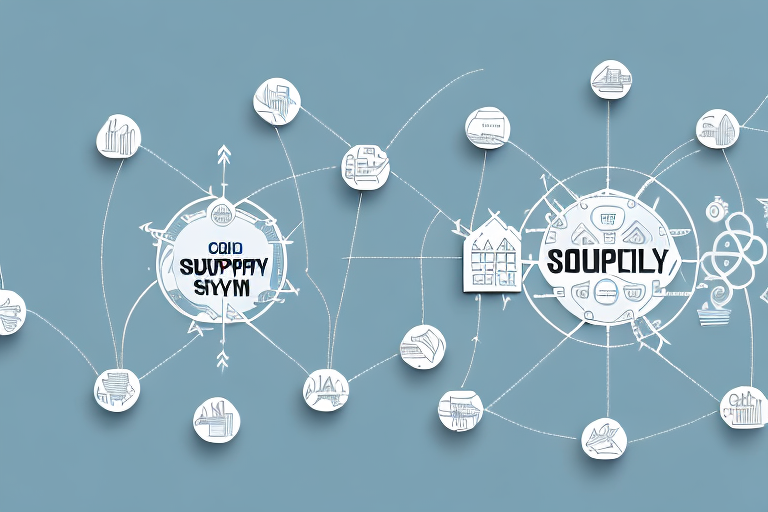Understanding the General Order of Supply Chain Management
In today's globalized economy, managing supply chains has become increasingly complex. To remain competitive and meet customer demands, companies must develop effective supply chain management strategies. This starts with understanding what supply chain management is and why it is important.
What is Supply Chain Management and Why is it Important?
Supply chain management involves the coordination of processes and activities involved in the production and distribution of goods and services from the supplier to the end customer. It encompasses everything from sourcing raw materials to delivering finished products to the consumer.
An effective supply chain management system is crucial for businesses as it can lead to increased efficiency, reduced costs, improved customer satisfaction, and better risk management. By streamlining operations and communication across the supply chain, companies can optimize their resources, minimize waste, and respond quickly to changing market conditions.
One of the key benefits of supply chain management is improved visibility and transparency. With a well-designed supply chain management system, businesses can track the movement of goods and services at every stage of the process. This allows them to identify potential bottlenecks, anticipate delays, and make informed decisions about inventory management and production planning.
According to a Supply Chain Digital report, companies that invest in supply chain visibility tools can reduce supply chain costs by up to 15%. This emphasizes the importance of adopting advanced technologies for real-time tracking and data analysis.
Another important aspect of supply chain management is sustainability. By implementing environmentally-friendly practices and reducing waste, companies can not only reduce their carbon footprint but also improve their reputation and attract environmentally-conscious customers. Sustainable supply chain management can also lead to cost savings in the long run, as companies can reduce their energy consumption and minimize the use of non-renewable resources.
The Components of a Supply Chain Management System
A supply chain management system is made up of several components, including:
- Planning: Developing a strategy for managing the supply chain
- Sourcing: Selecting and managing suppliers
- Making: Managing production processes
- Delivering: Coordinating the delivery of products to customers
- Returning: Managing returns and reverse logistics
Each of these components must be integrated seamlessly to ensure a smooth and efficient supply chain. Effective communication and collaboration between all parties involved is crucial in achieving this.
One of the key challenges in supply chain management is managing risk. This includes identifying potential risks, such as supplier bankruptcy or natural disasters, and developing contingency plans to mitigate their impact on the supply chain. Risk management is an ongoing process that requires constant monitoring and adjustment.
Another important aspect of supply chain management is sustainability. Companies are increasingly focused on reducing their environmental impact and ensuring ethical practices throughout their supply chain. This includes sourcing materials from sustainable sources, reducing waste and emissions, and ensuring fair labor practices.
The Benefits of an Effective Supply Chain Management Strategy
Implementing an effective supply chain management strategy can lead to a number of benefits for businesses, including:
- Increased efficiency: Reducing waste and minimizing downtime
- Reduced costs: Optimizing resources and improving productivity
- Improved customer satisfaction: Delivering products on time and with consistent quality
- Better risk management: Anticipating and mitigating potential supply chain disruptions
Another benefit of an effective supply chain management strategy is improved collaboration with suppliers and partners. By establishing strong relationships and communication channels, businesses can work together to identify opportunities for improvement and streamline processes. This can lead to faster delivery times, better quality control, and ultimately, increased customer satisfaction.
In addition, an effective supply chain management strategy can also help businesses stay competitive in a rapidly changing market. By continuously monitoring and adapting to market trends, businesses can adjust their supply chain processes to meet evolving customer demands and stay ahead of the competition. This can include implementing new technologies, exploring alternative sourcing options, and optimizing logistics and transportation networks.
The Challenges of Implementing a Successful Supply Chain Management System
While the benefits of effective supply chain management are clear, implementing a successful system can be a challenge. Some of the common obstacles companies face include:
- Legacy systems and data silos
- Lack of visibility across the supply chain
- Inconsistent processes and procedures
- Communication breakdowns between suppliers, manufacturers, and distributors
To overcome these challenges, companies must commit to investing in the necessary technology and infrastructure, fostering a culture of collaboration and communication, and implementing standardized processes and procedures.
One of the biggest challenges in implementing a successful supply chain management system is managing risk. Supply chains are vulnerable to a variety of risks, including natural disasters, geopolitical instability, and economic downturns. Companies must develop contingency plans and risk management strategies to mitigate these risks and ensure continuity of operations.
Another challenge is keeping up with the rapidly evolving technology landscape. New technologies such as blockchain, artificial intelligence, and the Internet of Things are transforming supply chain management, but implementing these technologies can be complex and costly. Companies must stay up-to-date with the latest trends and innovations in order to remain competitive.
Steps to Develop a Strong Supply Chain Management Plan
To develop a strong supply chain management plan, businesses should follow these steps:
- Identify the key players in the supply chain
- Understand the processes and procedures involved in each component
- Develop a communication strategy to ensure everyone is on the same page
- Invest in technology solutions to optimize supply chain operations
- Monitor and evaluate performance regularly to identify areas for improvement
Once a strong supply chain management plan has been developed, it is important to continuously review and update it to ensure it remains effective. This can involve conducting regular audits of the supply chain to identify any potential risks or areas for improvement. It may also involve seeking feedback from key stakeholders, such as suppliers and customers, to ensure their needs are being met.
Another important aspect of supply chain management is risk management. Businesses should have contingency plans in place to deal with any potential disruptions to the supply chain, such as natural disasters or supplier bankruptcies. This can involve identifying alternative suppliers or developing backup inventory plans to ensure continuity of supply.
How to Optimize Your Supply Chain for Increased Efficiency and Cost Savings
To optimize your supply chain, businesses should consider implementing the following strategies:
- Develop a centralized inventory management system to reduce waste and manage inventory levels effectively
- Deploy a transportation management system to optimize delivery routes and reduce transportation costs
- Implement lean manufacturing principles to minimize waste and improve productivity
- Partner with suppliers to build long-term relationships and optimize supply chain partnerships
Another strategy to optimize your supply chain is to implement automation technologies. Automation can help reduce manual labor, increase accuracy, and improve efficiency. For example, automated inventory tracking systems can help businesses keep track of inventory levels in real-time, reducing the risk of stockouts and overstocking.
Additionally, businesses can optimize their supply chain by implementing sustainability practices. This includes reducing waste, using eco-friendly materials, and minimizing the carbon footprint of transportation. By implementing sustainable practices, businesses can not only reduce costs but also improve their reputation and attract environmentally conscious customers.
Best Practices for Managing Your Supply Chain in Today's Globalized Economy
To effectively manage your supply chain in today's globalized economy, businesses should follow these best practices:
- Embrace digitalization to improve visibility and communication across the supply chain
- Invest in advanced analytics and data-driven decision-making to optimize supply chain operations
- Build a diverse and resilient supply chain to mitigate risk and ensure continuity of operations
- Continually monitor and evaluate performance to identify areas for improvement
Another important best practice for managing your supply chain in today's globalized economy is to establish strong relationships with your suppliers. This includes regular communication, collaboration, and transparency to ensure that both parties are aligned and working towards common goals. By building strong relationships with your suppliers, you can also gain access to new technologies, innovations, and market insights that can help you stay ahead of the competition.
Finally, it's important to prioritize sustainability and social responsibility in your supply chain management practices. This includes reducing waste, minimizing your carbon footprint, and ensuring that your suppliers adhere to ethical labor practices. By prioritizing sustainability and social responsibility, you can not only improve your brand reputation and customer loyalty, but also contribute to a more sustainable and equitable global economy.
The Role of Technology in Enhancing Your Supply Chain Management Efforts
Advances in technology have revolutionized the way companies manage their supply chains. Some of the key technologies used in supply chain management include:
- Transportation management systems
- Warehouse management systems
- Inventory management systems
- Enterprise resource planning software
- Supply chain analytics software
By leveraging these technologies, companies can optimize their supply chain operations, enhance visibility across the supply chain, and improve decision-making processes.
One of the most significant benefits of using technology in supply chain management is the ability to track products and shipments in real-time. This allows companies to quickly identify and address any issues that may arise, such as delays or quality control problems. Additionally, technology can help companies reduce costs by automating certain processes, such as order fulfillment and inventory management. By streamlining these processes, companies can reduce the amount of time and resources required to manage their supply chains, ultimately improving their bottom line.
Common Mistakes to Avoid When Implementing a Supply Chain Management System
Some common mistakes companies make when implementing a supply chain management system include:
- Failure to define goals and objectives clearly
- Underestimating the complexity of the supply chain and neglecting to involve all stakeholders
- Failure to invest in the necessary technology and infrastructure
- Overreliance on a single supplier or logistical solution
To avoid these mistakes, companies must take a comprehensive and collaborative approach to supply chain management, investing in the latest technology and strategies, and continuously evaluating and optimizing their processes.
Another common mistake that companies make when implementing a supply chain management system is failing to establish clear communication channels with suppliers and partners. This can lead to misunderstandings, delays, and disruptions in the supply chain. To avoid this, companies should establish open lines of communication with all stakeholders, including suppliers, distributors, and customers. They should also establish clear protocols for sharing information and resolving issues in a timely manner.
Conclusion
Effective supply chain management is critical for businesses in today's globalized economy. By developing a comprehensive and collaborative plan, leveraging the latest technology and analytics tools, and continually evaluating and optimizing processes, companies can enhance efficiency, improve customer satisfaction, and reduce costs.
Furthermore, supply chain management plays a crucial role in sustainability efforts. By implementing environmentally-friendly practices and sourcing materials from ethical suppliers, companies can reduce their carbon footprint and contribute to a more sustainable future. Consumers are increasingly demanding transparency and accountability from businesses, and a responsible supply chain can help companies meet these expectations and build a positive reputation.






















